|
Current Issue - Spring/Summer 2013 Show Back Issues |
| ||
Tree Tips NewsletterFor more tree care information, view our latest edition of Tree Tips on the Bartlett Tree Experts site. Common Native Shade Tree Bigleaf Maple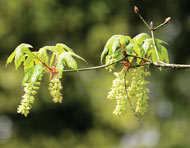 Bigleaf Maples produce greenish-yellow flowers before sprouting their signature 6 to 12” wide leaves.
Bigleaf Maples produce greenish-yellow flowers before sprouting their signature 6 to 12” wide leaves.
In the Willamette Valley, our most common deciduous native tree is the bigleaf maple. It gets its name from the size of its leaves. In Latin, the species name Acer macrophyllum means big leaf: macro meaning large and phyllum meaning leaf. The bigleaf maple has the largest leaf of any maple in the world, measuring 6-12 inches across and having five lobes, resembling a human hand. It has a long single leaf stalk and when pulled from the tree it exudes a milky sap. The yellow fall color against the dark foliage of its common forest associate, the Douglas fir, is spectacular. This large shade tree can grow to heights of 70 to 100 feet tall and have trunks up to four feet in diameter. The trunks are often multi-stemmed because it readily re-sprouts from stumps. The bark is often covered with moss, lichens and ferns that add to the maple’s beauty. The greenish yellow flowers are produced on long clusters in the early spring. The hairy seeds of a big leaf maple are two samaras (papery fruit) that resemble an airplane propeller. During the fall they are a popular amusement for kids and tree lovers who enjoy tossing them in the air and watching them spin to the ground like a helicopter. Bigleaf Maple grows on the west side of the Cascades from British Columbia south through California. It can form pure stands on moist soils near streams but can also be found growing in forests with Douglas fir or Garry oak. In urban areas, it is a common native tree found growing in parks, school grounds or casting its shade over back yards. 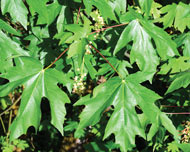 Bigleaf Maples provide year-round delights with their signature Fall color and helicopter seeds, and their expansive shade producing leaves.
Bigleaf Maples provide year-round delights with their signature Fall color and helicopter seeds, and their expansive shade producing leaves.
Bigleaf maples often produce burls on the trunk which are highly prized for furniture making. A burl is a type of a round deformed growth found on trunks or branches that is filled with small knots from dormant buds. When burls are cut, they reveal peculiar distorted grain patterns desired by furniture makers and artists. Maple wood also makes excellent firewood. Insects that may infest bigleaf maple include aphids and box elder bugs. Verticillium (see article at right) a common fungal disease can also kill maples of many varieties. Bigleaf maples can also form multiple stems, prone to splitting (see codominant stem article). Squirrels will feed on maple branches, girdling them, and causing them to die in the summer. The young maple saplings are an important source of food or browse for deer. Enjoy the bigleaf maple for its many attributes including shade, wildlife benefits, fall color and entertaining helicopter seeds. |
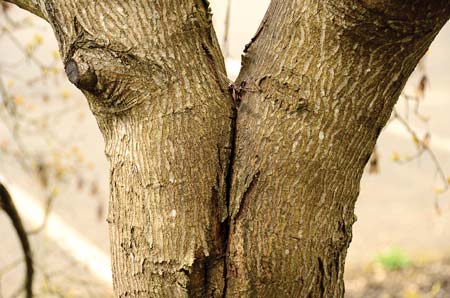 Example of a co-dominant trunk where two stems have grown to about the same diameter and are pushing against each other. Co-dominant Stems: A Sign of Tree WeaknessEvery year, trees may fall or break, causing property damage, power outages, and injury. While some tree failures are unpredictable, many can be prevented. By inspecting your trees for warning signs, potential problems can be averted. Weak fork failures are more common in some species and cultivars of trees, such as various species of willow, poplar, maple, ash, Flowering pear and cedars including Cedrus spp. and Thuja plicata (our local native, Western red cedar). When choosing young trees from the nursery, select trees with a single straight leader; avoid trees with codominant or multiple stems. Most structural problems can be prevented by proper training when trees are young. Wise pruning and possibly cabling can minimize problems in mature trees. Sometimes it is best to remove a hazardous branch or even the entire tree. Trees are alive. Their integrity and stability change over time. Inspect trees regularly to ensure their longevity and health. The cost of prevention is usually much less than the cost of loss and inconvenience of damage. Call a Certified Arborist from Collier Arbor Care to do a visual tree risk assessment and receive expert advice on remedy or possible removal. “True” Bug Insects Making a StinkThere is a saying: “all bugs are insects but not all insects are bugs”. True bugs belong to the Hemiptera order of insects. The Greek-derived name means half (hemi) wing (ptera). This refers to the wings — hardened at the base but membranous at the ends. 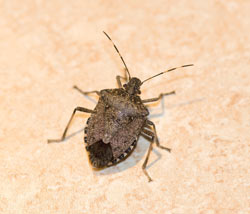
Stink Bug True bugs also have a characteristic triangle on their backs. Although their size and form can vary, they all have sucking mouthparts which are typically held under their bodies. Some bugs prey on other insects, but the majority suck plant juices. The box elder bug, and the brown marmorated stink bug (BMSB) are examples of home and landscape nuisance insects. The BMSB can potentially be destructive as a garden and fruit tree pest in our area. Adult boxelder bugs are about a half inch long, black with orange or red markings, including three stripes right behind the head. The adults and nymphs feed primarily on foliage and seeds of maple trees. Boxelder bugs will enter homes and buildings in the fall, reappear in the spring, often in large numbers, creating a nuisance. Fortunately, they do not bite people and are essentially harmless to property. Boxelder bugs will release a pungent and bad-tasting compound upon being disturbed to discourage predation. 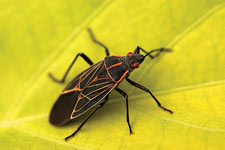
Boxelder Bug The brown marmorated stink bug was accidentally introduced from China a decade ago. Adults are approximately three quarters of an inch long and are shades of brown on both the upper and lower body surfaces. (Marmorated means having a marbled or streaked appearance.) Alternating light and dark bands on their antennae distinguish them from other stink bugs. This stink bug can cause widespread damage to fruit and vegetable crops, such as apples peaches, corn and beans. It uses its proboscis, or sucking mouthparts, to pierce plant tissues to feed; resulting in dimpled or necrotic areas in plant tissue. Touching the stink bug can release a pungent odor. Like the boxelder bug, the BMSB invades homes to hibernate and can be a nuisance indoors. Mechanical exclusion is the best method to keep stink bugs and other insects from entering homes and buildings. Cracks around windows, doors, siding, and other openings should be sealed. Occasionally when numbers are so large you may want to treat exterior walls of buildings. If found indoors, vacuum up the stink bugs but realize a certain amount of tolerance may be necessary. Because invasive insect species have few natural predators, expect to see increasing numbers and damage from the brown marmorated stink bug in our area in the future. 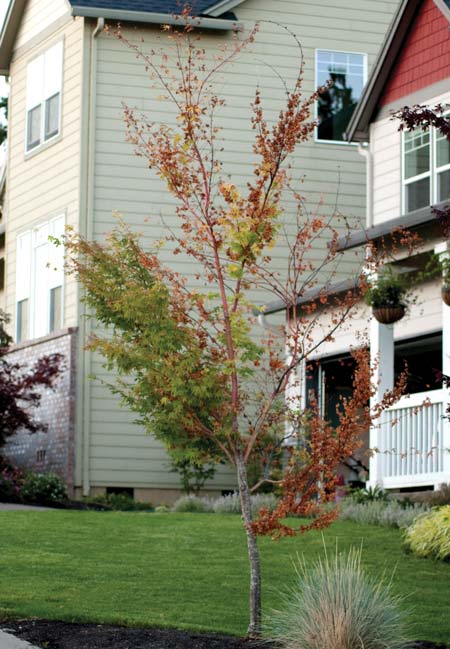 A Maple suffering from Verticillium wilt. Verticillium Wilt: A Deadly Disease in MaplesVerticillium wilt is a common destructive disease which can occur in many kinds of plants, including over 200 species of broadleaf shade and ornamental trees and shrubs. It is frequently diagnosed in our area because it kills so many plants. The plant species most likely infested include: maples (Acer), redbud (Cercis), ash (Fraxinus), smoke tree (Cotinus), euonymus, rose, tomatoes, and strawberries. Verticillium lives in the soil and attacks susceptible plants through the roots. Once inside a plant, the fungi grow inside and upward in current year’s wood, causing water-conducting vessels (xylem) to plug with gums and other materials. Thus, transport of water absorbed by roots is restricted, and portions of the crown above plugged areas wilt and die back. In large trees the fungus spreads slowly, and infected trees may take many years to die. Small trees, however, may be killed within a year or two. Sometimes, despite having the disease, vigorous and well cared for trees can simply “outgrow” the disease by adding new, healthy wood and xylem. Often, very old maple trees, when removed, are found to have been “fighting” the Verticillium wilt disease for decades. Symptoms: Wilting, yellowing or browning and death of leaves may begin in twigs of one branch and progress slowly through the plant. Diseased trees show dead and dying (wilting) branches, sparse crowns, and sharply reduced twig growth, progressing to the death of the whole tree. Infected sapwood (xylem vessels) may have dark greenish streaks in the sapwood and discolored growth rings. This discoloration may be absent during the earliest stages of infection and in some tree species. Control of Verticillium wilt is difficult because the pathogens live in the soil and form microscopic resting structures that are resistant to conventional fungicides. There are no chemical controls that reliably cure the disease, so the following cultural controls are recommended:
Plant resistant species back in the area where a plant has died due to Verticillium. The soil is now contaminated with high amounts of the disease making it likely for re-infection of new plants. All conifers are resistant. Other resistant trees include birch, dogwood, katsura, beech, crabapple, oak and rhododendron to name a few. Avoid using fresh woodchips from trees infected with Verticillium but it is OK to use composted mulch because the composting process kills most soil pathogens. 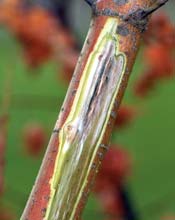
Dark greenish streaks can sometimes be seen in the sapwood of an infected tree or shrub. Although Verticillium is one of our most common and destructive diseases, it can be managed and infected trees allowed to live for years with the disease if properly cared for. |
|
Home |
Services |
The Arbor Advisor |
Garden Calendar |
About Us |
Fact Sheets |
Contact Us |
Site Map Collier Arbor Care Portland 503-722-7267 Vancouver (360) 693-6056 Site contents and design ©2013 Collier Arbor Care |
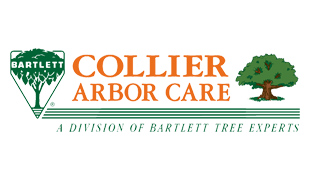






 top »
top »